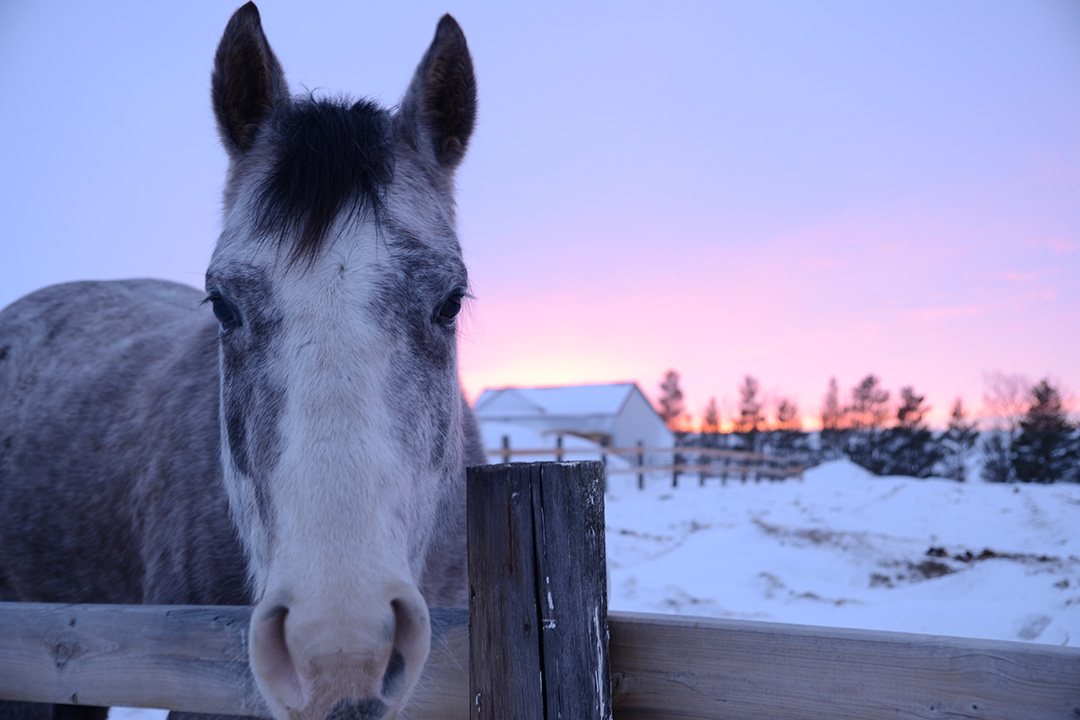
Melanoma and grey horses
Anyone who has owned a grey horse knows the struggle of trying to keep their equine friend clean and to prevent them from becoming a shade of brown.
By Whitney JirickaHowever, owners of grey horses often face a far more serious problem than mud. On average, grey horses have an 80 per cent chance of developing a melanoma (skin cancer) during their lives. Melanomas develop when skin cells that contain melanin deposit excessive pigment, leading to abnormal production.
As both a veterinary student and the owner of a grey horse, I have always been worried about melanomas. Since the prevalence of these cancerous growths is significantly higher in grey horses, there’s cause for concern throughout the equine industry.
Dr. Michelle Husulak, a lecturer/clinical faculty member at the Western College of Veterinary Medicine (WCVM) and a member of the Equine Field Service at the WCVM Veterinary Medical Centre, has similar concerns.
“It is very rare to find a grey horse over the age of 15 that has none. The vast majority of them have one or two little nodules somewhere on their body,” says Husulak, who has a special interest in equine skin conditions. “In horses they [the growths] are usually benign, which is not the case in other species.”
Benign tumours do not metastasize or spread to other areas of the body, unlike malignant or cancerous tumours. Melanomas in horses tend to remain within the skin but may occasionally be found elsewhere in the body.
Inherited genetics may be a factor of cancer development as researchers have reported a mutation in the STX17 (syntaxin-17) gene that’s linked to melanoma incidence in grey horses. Melanomas developing in non-grey horses are generally uncommon but are still possible.
Melanomas usually show up as black lumps on the skin of the perineum — at the base of the tail and around the anus. Husulak has also diagnosed them in the parotid (salivary) glands and guttural pouches, as well as on the lips, between the legs and on the upper and lower limbs. They may also appear as individual nodules throughout the body.
While sunlight has been considered a possible risk factor for melanoma, the growths’ location isn’t typical of skin conditions caused by exposure to the sun.
“If it was UV (ultra-violet) [ray] related, we would see more of them on the face and not so many around the anus and underneath the tail,” says Husulak. “They often get them in areas that are not being exposed to sunlight.”
Husulak points out that not all tumours cause clinical problems, adding that the main health implications of melanomas are completely situational. Areas with severe melanomas around the anus can lead to problems defecating, or tumours in areas where tack is rubbing can lead to discomfort for the horse when riding. As well, tumours on or around the lip area can lead to issues with eating.
Besides external tumours, melanomas can also develop internally — but these are quite uncommon.
“As a vet, you try to alleviate concerns by horse owners, but there is not a whole lot we can do. If the masses become large or get in the way, removal is the best thing you can do for the horse,” says Husulak.
If the tumour is situated in a bad spot, a veterinarian usually removes it by surgical excision. But if it’s not causing issues, the tumour isn’t generally removed. To remove small, non-invasive tumours, veterinarians can surgically remove the tissue or use a carbon dioxide laser as a treatment option. Cryosurgery, which freezes and destroys the tumour tissue, works well in treating small, non-invasive melanomas. Radiation therapy can also work well for smaller tumours.
On the medicine side, cisplatin is a type of chemotherapy that veterinarians have used to control growth and shrink the tumour, but it’s likely only suitable if the cancer is caught early. Cimentidine, an antihistamine drug, has been reported to slow down growth in some melanomas.
“Removal of melanomas is quite successful, and the horses have improved. They [the horses] often get more melanomas later on but they do not usually grow back in the same place that you removed one [tumour] from,” says Husulak.
In recent studies, researchers have been attempting to develop immunotherapeutic approaches as tumour cells express certain proteins that the body recognizes as foreign and will attack. In small animal oncology, scientists recently developed the first DNA-based canine cancer vaccine called ONCEPT to treat canine oral melanoma tumours after surgical treatment.
The potential use of a similar vaccine in horses requires further research.
“There is a vaccine that is used in dogs very commonly and has some limited success in horses. In my personal experience, I found that while we are actively administering the vaccine on a regular interval within a short period of time it does shrink the melanomas. It does not eliminate them, but it does shrink them. Then when you move to once every six months, they go back to the size they were originally,” says Husulak.
Additionally, this vaccine is not a great long-term option as it costs around $400 per dose. But still, Husulak believes vaccines represent the future for equine melanoma treatment
“There is no way to know where all the affected cells are, and a vaccine is a whole-body treatment rather than a localized treatment,” she says.
Whitney Jiricka of Rosetown, Sask., is a WCVM veterinary student who worked as a summer research student in 2022. Her story is part of a series of articles written by WCVM summer research students.
